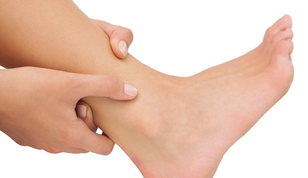Blog Categories
Search Blog
Blog Categories
Understanding Ankle Sprains
Ankle sprains are a common injury seen in young children. They often occur during a sporting event, but can also happen while simply playing in the school yard. The child rolls over on an ankle, most commonly inward.
Ankle sprains are classified in 3 categories:
Grade 1: Mild damage to the ligament without instability
Grade 2: Some tearing of the ligament with some instability
Grade 3: Complete tear of the ligament
All grades of sprains are associated with some degree of pain and swelling and often some bruising is also evident in grades 2 and 3. The acronym “RICE” summarizes initial treatment:
- R: Rest from the activity
- I: Ice approximately 10 -15 minutes
- C: Compression, typically tensor wrapping during the day, remove at night
- E: Elevation, to allow the lymphatic system to absorb inflammation
Physiotherapy treatment can be helpful to determine the severity of the injury and to aid in recovery. Physiotherapy treatment begins with measuring the range of motion, strength and balance of the injured ankle. Ultrasound and other modalities can also be used to facilitate the healing process. Manual therapy is a very important and crucial component in restoring full range of motion.
The exercise component in physiotherapy rehabilitation of is essential. This often begins with Theraband exercises and close instruction to not overstretch the healing ligament. These exercises should be progressed to closed chain exercises (weight bearing exercises) which will incorporate proprioceptive (balance) response.
The final component to a safe return to sports is for a physiotherapist or athletic coach to take the child through plyometrics and agility drills in which jumping, stops and starts, and balance control are examined. It is important that the child demonstrates normal response and control in order to return to sports and not risk re-injury. It is my opinion that repeat ankle sprains are common because one component of the rehabilitation has not been met and the child has returned to play too soon.
Lastly, parents ask me all the time if the child wears a brace, can they return to the sport sooner? My recommendation is NO! The brace should not be used to allow an acutely injured ankle to return to play, but to support an ankle that is fully ready to return to the sport. This means that the range of motion, strength and balance of the injured ankle is the same as the non-injured side.
All in all, it is important to have the ankle properly assessed so the child does not re-injure it, which could lead to chronic instability.
References
Hubbard, T.J. & Denegar, C.R. (2004). Does cryotherapy improve outcomes with soft tissue injury? J Athl Train, 39 (11), 88-94.
Jam, B. (2014). Questioning the use of ice given inflammation is a perfectly healthy response following acute musculoskeletal injuries. Advanced Physical Therapy Education Institute ( APTEI), Thornhill, ON, Canada. Article published on www.aptei.com “Clinical Library”.
Takagi, R, et al. (2011). Influence of iceing on muscle regeneration after crush injury to skeletal muscles in rats. J of App Phys, 110 (2), 382-388.






